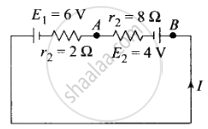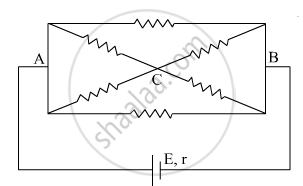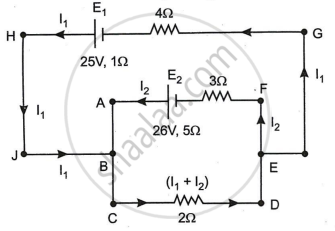Advertisements
Advertisements
Question
The circuit in figure shows two cells connected in opposition to each other. Cell E1 is of emf 6V and internal resistance 2Ω; the cell E2 is of emf 4V and internal resistance 8Ω. Find the potential difference between the points A and B.
Solution
In this problem, after finding the electric current flow in the circuit by using Kirchoff’s law or Ohm’s law, the potential difference across AB can be obtained.

Applying Ohm's law.
Equivalent emf of two cells = 6 – 4 = 2V and equivalent resistance = 2Ω + 8Ω = 10Ω, so the electric current is given by
`I = (6 - 4)/(2 + 8)` = 0.2 A
Taking loop in anti-clockwise direction, since E1 > E2
The direction of flow of current is always from high potential to low potential.
Therefore VB > VA.
⇒ VB – 4V – (0.2) × = VA
Therefore, VB – VA = 3.6V
Important point: Sign convention for the application of Kirchoff’s law: For the application of Kirchoff’s laws following sign convention are to be considered.
(i) The change in potential in traversing a resistance in the direction of current is – iR while in the opposite direction + iR.

(ii) The change in potential in traversing as emf source from negative to positive terminal is +E while in the opposite direction – E irrespective of the direction of current in the circuit.

APPEARS IN
RELATED QUESTIONS
Given n resistors each of resistance R, how will you combine them to get the (i) maximum (ii) minimum effective resistance? What is the ratio of the maximum to minimum resistance?
The current is drawn from a cell of emf E and internal resistance r connected to the network of resistors each of resistance r as shown in the figure. Obtain the expression for
- the current draw from the cell and
- the power consumed in the network.

ε1 and ε2 are two batteries having emf of 34V and 10V respectively and internal resistance of 1Ω and 2Ω respectively. They are connected as shown in the figure below. Using Kirchhoff’s Laws of electrical networks, calculate the currents I1 and I2.

Twelve wires each having a resistance of 3 Ω are connected to form a cubical network. A battery of 10 V and negligible internal resistance is connected across the diagonally opposite corners of this network. Determine its equivalent resistance and the current along each edge of the cube.
State the principle of potentiometer.
Kirchhoff’s second law is a consequence of law of conservation of ______.
Assertion: Kirchhoff’s junction rule follows from conservation of charge.
Reason: Kirchhoff’s loop rule follows from conservation of momentum.
Two cell of 1.25 V and 0.75 V are connected parallel. The effective voltage will be:-
Why are alloys used for making standard resistance coils?
In the circuit shown in Figure below, E1 and E2 are batteries having emfs of 25V and 26V. They have an internal resistance of 1 Ω and 5 Ω respectively. Applying Kirchhoff’s laws of electrical networks, calculate the currents I1 and I2.

